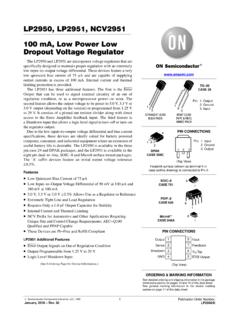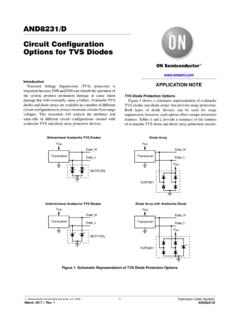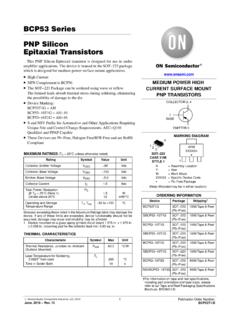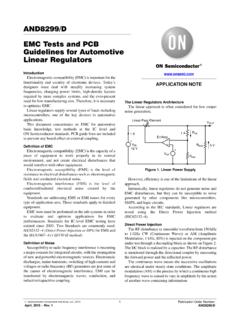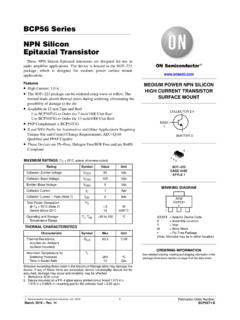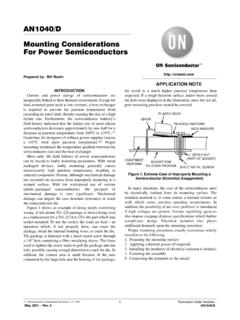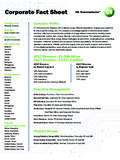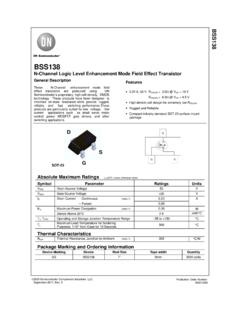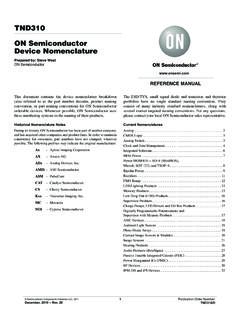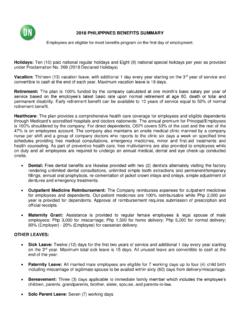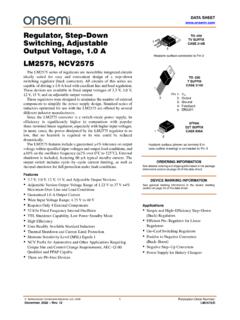Transcription of LM337 - Voltage Regulator - Adjustable Output, Negative
1 DATA Semiconductor Components Industries, LLC, 2015 October, 2021 Rev. 111 Publication Order Number: LM337 /DVoltage Regulator - Adjustable Output, ALM337 The LM337 is an Adjustable 3 terminal Negative Voltage regulatorcapable of supplying in excess of A over an output Voltage range of V to 37 V. This Voltage Regulator is exceptionally easy to useand requires only two external resistors to set the output , it employs internal current limiting, thermal shutdown andsafe area compensation, making it essentially blow out LM337 serves a wide variety of applications including local, oncard regulation.
2 This device can also be used to make a programmableoutput Regulator , or by connecting a fixed resistor between theadjustment and output, the LM337 can be used as a precision Output Current in Excess of A Output Adjustable between V and 37 V Internal Thermal Overload Protection Internal Short Circuit Current Limiting Constant with Temperature Output Transistor Safe Area Compensation Floating Operation for High Voltage Applications Eliminates Stocking many Fixed Voltages Available in Surface Mount D2 PAK and Standard 3 Lead TransistorPackage These Devices are Pb Free and are RoHS CompliantFigure 1.
3 Standard ApplicationVout + V 1)R2R1 * Cin is required if Regulator is located more than 4 inches from power supply filter. * A mF solid tantalum or 10 mF aluminum electrolytic is recommended.** CO is necessary for stability. A mF solid tantalum or 10 mF aluminum electrolytic ** is * mF+-VinVinVout-VoutCO** mF+IAdjR1120R2 THREE TERMINALADJUSTABLE NEGATIVEVOLTAGE REGULATORTO 220 ABT SUFFIXCASE 221AB1 MARKINGDIAGRAMSLM337xxAWLYWWGPin 1. Adjust2. Vin3. VoutHeatsink surfaceconnected to Pin detailed ordering and shipping information in the packagedimensions section on page 8 of this data INFORMATIONxx= BT, Tyyyy = BD2T, D2TA= Assembly LocationWL= Wafer LotY= YearWW = Work WeekG=Pb Free PackageD2 PAKD2T SUFFIXCASE 936 Heatsink surface (shown as terminal 4 in case outline drawing) is connected to Pin RATINGS (TA = +25 C, unless otherwise noted)
4 RatingSymbolValueUnitInput Output Voltage DifferentialVI VO40 VdcPower DissipationCase 221 ATA = +25 CThermal Resistance, Junction to AmbientThermal Resistance, Junction to CaseCase 936 (D2 PAK)TA = +25 CThermal Resistance, Junction to AmbientThermal Resistance, Junction to CasePDqJAqJCPDqJAqJCInternally C/W C/WW C/W C/WOperating Junction Temperature RangeTJ 40 to +125 CStorage Temperature RangeTstg 65 to +150 CStresses exceeding those listed in the Maximum Ratings table may damage the device. If any of these limits are exceeded, device functionalityshould not be assumed, damage may occur and reliability may be CHARACTERISTICS(|VI VO| = V; IO = A for T package; TJ = Tlow to Thigh [Note 1]; Imax and Pmax [Note 2].)
5 CharacteristicsFigureSymbolMinTypMaxUnit Line Regulation (Note 3), TA = +25 C, V |VI VO| 40 V1 Regline Regulation (Note 3), TA = +25 C, 10 mA IO Imax|VO| V|VO| V2 Regload VOThermal Regulation, TA = +25 C (Note 5), 10 ms PulseRegtherm VO/WAdjustment Pin Current3 IAdj 65100mAAdjustment Pin Current Change, V |VI VO| 40 V, 10 mA IL Imax, PD Pmax, TA = +25 C1, 2 DIAdj Voltage , TA = +25 C, V |VI VO| 40 V, 10 mA IO Imax, PD Pmax, TJ = Tlow to Thigh3 Vref Regulation (Note 3), V |VI VO| 40 V1 Regline Regulation (Note 3), 10 mA IO Imax |VO| V|VO| V2 Regload VOTemperature Stability (Tlow TJ Thigh)3TS % VOMinimum Load Current to Maintain Regulation(|VI VO| 10 V)(|VI VO| 40 V)3 ILmin Output Current|VI VO| 15 V, PD Pmax, T Package|VI VO| 40 V, PD Pmax, TJ = +25 C, T Package3 Imax Noise, % of VO, TA = +25 C, 10 Hz f 10 kHzN % VORipple Rejection, VO = 10 V, f = 120 Hz (Note 4)Without CAdjCAdj = 10 mF4RR 666077 dBLong Term Stability, TJ = Thigh (Note 6)
6 , TA = +25 C for Endpoint Measurements3S Resistance, Junction to Case, T PackageRqJC C/WProduct parametric performance is indicated in the Electrical Characteristics for the listed test conditions, unless otherwise noted. Productperformance may not be indicated by the Electrical Characteristics if operated under different Tlow to Thigh = 0 to +125 C, for LM337T, D2T. Tlow to Thigh = 40 to +125 C, for LM337BT, Imax = A, Pmax = 20 W3. Load and line regulation are specified at constant junction temperature. Change in VO because of heating effects is covered under theThermal Regulation specification.
7 Pulse testing with a low duty cycle is CAdj, when used, is connected between the adjustment pin and Power dissipation within an IC Voltage Regulator produces a temperature gradient on the die, affecting individual IC components on the effects can be minimized by proper integrated circuit design and layout techniques. Thermal Regulation is the effect of thesetemperature gradients on the output Voltage and is expressed in percentage of output change per watt of power change in a specified Since Long Term Stability cannot be measured on each device before shipment, this specification is an engineering estimate of averagestability from lot to Schematic DiagramFigure 1.
8 Line Regulation and DIAdj/Line Test Circuit*VOHVOLLine Regulation (% V) + |VOL VOH||VOH|x mFR21%CO+RLAdjustVinVoutR11201%VEE* Pulse testing required. 1% Duty Cycle is mFVIHVILIAdjThis device contains 39 active 2. Load Regulation and DIAdj/Load Test CircuitFigure 3. Standard Test CircuitFigure 4. Ripple Rejection Test CircuitVO (min Load) - VO (max Load) mFR21%R1120CO+RL(maxLoad)AdjustVin-VILM3 37 Vout* Pulse testing required. 1% Duty Cycle is Regulation (mV) = VO (min Load) - VO (max Load)Load Regulation (% VO) =x mF-VO (min Load)-VO (max Load)VORL+ mFCOR11201%R2 CinAdjustVinLM337To Calculate R2:R2 =- 1R1 This assumes IAdj is negligible.
9 * Pulse testing required.* 1% Duty Cycle is mFVoutRL+ mFCO1N4002D1*Cin1% Vf = 120 HzCAdj+Vout = V* D1 Discharges CAdj if output is shorted to mF10mFVoutVO*VO (min Load) 5. Load RegulationFigure 6. Current LimitFigure 7. Adjustment Pin CurrentFigure 8. Dropout VoltageFigure 9. Temperature StabilityFigure 10. Minimum Operating Current Vout, OUTPUT Voltage CHANGE (%)IL = AIL = AVin = -15 VVout = -10 VIout, OUTPUT CURRENT (A)TJ = 25 C, ADJUSTMENT CURRENT (Adj A)IVinout, INPUT-OUTPUT Voltage - A500 mA200 mA20 mAVout = VDVO = 100 mVIL = AVref, REFERENCE Voltage (V), QUIESCENT CURRENT (mA)BITJ = 25 CDIFFERENTIAL (Vdc) , JUNCTION TEMPERATURE ( C)0 10203040 Vin-Vout , INPUT-OUTPUT Voltage DIFFERENTIAL (Vdc)-50-250255075100125150TJ, JUNCTION TEMPERATURE ( C)-50-250255075100125150TJ, JUNCTION TEMPERATURE ( C)
10 -50-250255075100125150TJ, JUNCTION TEMPERATURE ( C)102030400 Vin-Vout , INPUT-OUTPUT Voltage DIFFERENTIAL (Vdc) 11. Ripple Rejection versus Output VoltageFigure 12. Ripple Rejection versus Output CurrentFigure 13. Ripple Rejection versus FrequencyFigure 14. Output ImpedanceFigure 15. Line Transient ResponseFigure 16. Load Transient Response010203040t, TIME (ms)VVOLTAGE CHANGE (V) in VVOLTAGE DEVIATION (V)out, INPUT, OUTPUT VVOLTAGE DEVIATION (V)outICURRENT (A)L, LOAD, OUTPUT010203040t, TIME (ms)Vout = -10 VIL = 50 mATJ = 25 CCL = mFWithout , RIPPLE REJECTION (dB)Vout, OUTPUT Voltage (V) , RIPPLE REJECTION (dB)IO, OUTPUT CURRENT (A) k10 k100 M10 MRR, RIPPLE REJECTION (dB)f, FREQUENCY (Hz) k10 k100 M, OUTPUT IMPEDANCE ( )O f, FREQUENCY (Hz)
